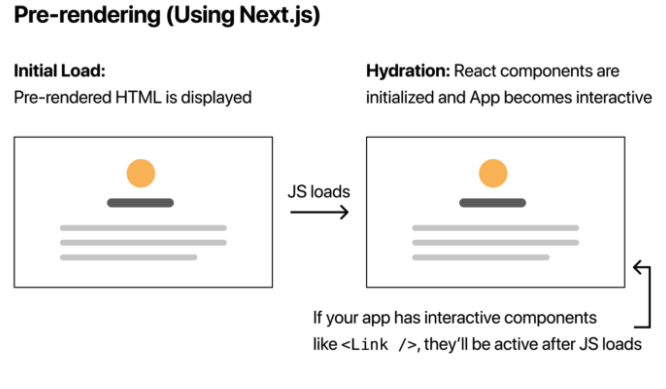1 ) Các vấn đề hiện tại đồi với Client Side rendering (CSR)
React, Angular và Vue được sử dụng để tạo các Single Page Application (SPA).Tất cả đều cung cấp CSR có nghĩa là toàn bộ nội dung sẽ được render từ phía client. Do đó việc hiển thị trang đầu tiên sẽ mất nhiều thời gian , do nó phải tải về toàn bộ javascript của bạn xuống và sau đó mới tiếp tục công việc hiện thị nội dung
Vì vậy, để hiển thị các trang nhanh hơn , chúng ta có thể sử dụng Next.js. Trang web của ban sẽ được render ra ở phía server và nhận được pre-rendered HTML , điều này thì khá tốt cho vấn đề SEO.
2 ) Server Side Rendering (SSR)
Khi người dùng yêu cầu một trang web, server sẽ chuẩn bị trang bằng cách tìm dữ liệu dành riêng cho người dùng và gửi đến máy của người dùng. Sau đó, trình duyệt sẽ hiểu nội dung và hiển thị trang. Toàn bộ quá trình tìm dữ liệu từ cơ sở dữ liệu, tạo trang HTML và cung cấp cho người dùng đều thực hiện ở phía server nên nó được gọi là SSR.
3 ) Next.js
Next.js xây dựng trang HTML tại thời điểm build và pre-rendered trang và gới nó cho browser với JavaScript tối thiểu mỗi khi trang được tải lại bởi trình duyệt, mã JavaScript của nó sẽ chạy và làm cho trang có tương tác . (Quá trình này được gọi là Hydration)

Trong Next.js có 2 cách chính để pre-rendering :
- Static Generation (SSG) : HTML sẽ được tạo ra tại thời điểm build
- Server Side Rendering: HTML sẽ được tạo ra trong mỗi lần request.
4 ) Ví dụ
Cài đặt
npx create-next-app
// hoặc
yarn create next-app
Các thư viện khác
- Material-UI .
- jsonplaceholder-api để lấy một số dữ liệu có sẵn.
- Axios.
Cấu hình file _app.js
import React, {Fragment} from 'react'
import Head from 'next/head'
import '../styles/globals.css'
function MyApp({ Component, pageProps }) {
return (
<Fragment>
<Head>
<title> List User</title>
<link rel="icon" href="/favicon.ico" />
</Head>
<Component {...pageProps} />
</Fragment>
)
}
export default MyApp
Ở đây chúng ta có sử dụng thẻ Head của next.js để thay đổi title cho trang web
Sau đó chúng ta tạo thư mục services/user.js
import axios from 'axios'
const BASE_URL = 'https://jsonplaceholder.typicode.com'
export const getAllUsers = async () => {
const users = await axios.get(`${BASE_URL}/user`})
.then(({data}) => {
return data
})
return users
}
Bây giờ, hãy tạo một thư mục users bên trong thư mục page và file index.js bên trong nó. Bất kỳ thư mục hoặc tệp nào bên trong thư mục page sẽ tự động trở thành trang web, vì vậy bây giờ bạn có thể truy cập trang này tại đường dẫn /users
Hãy tạo một hàm bất đồng bộ getStaticProps cung cấp các props cho component. Hàm này sẽ gọi getAllUsers và trả về danh sách người dùng
export const getStaticProps = async () => {
const allUsers = await getAllUsers()
return {
props: {
allUsers
}
}
}
Bây giờ chung ta sẽ tạo một component sẽ render ra một cái card chưa thông tin của user . Và nhận các props tư allUsers
//components/card/index.js
import React from 'react'
import { makeStyles } from '@material-ui/core/styles'
import Card from '@material-ui/core/Card'
import CardActionArea from '@material-ui/core/CardActionArea'
import CardContent from '@material-ui/core/CardContent'
import CardMedia from '@material-ui/core/CardMedia'
import Typography from '@material-ui/core/Typography'
import styles from '../../styles/Card.module.css'
const UserCard = ({name, email, id, image}) => {
const classes = useStyles()
return (
<Card className={styles.root}>
<CardActionArea>
<CardMedia
component="img"
alt="user image"
height="200"
image={image}
/>
<CardContent>
<Typography className={classes.text} gutterBottom
variant="h5" component="h2">
{name}
</Typography>
<Typography className={classes.text} variant="body2"
color="textSecondary">
{email}
</Typography>
</CardContent>
</CardActionArea>
</Card>
)
}
const useStyles = makeStyles({
root: {
maxWidth: 250,
padding: 5
},
text: {
textOverflow: 'ellipsis',
whiteSpace: 'nowrap',
overflow: 'hidden',
}
})
export default UserCard
Update pages/users/index.js lại như sau
import React from 'react'
import Grid from '@material-ui/core/Grid'
import { getAllUsers } from '../../lib/users'
import UserCard from '../../components/card'
const Users = ({allUsers}) => {
return (
<Grid container spacing={5} justify="space-evenly">
{allUsers.data.map(({id, firstName, email, picture}) => (
<Grid item xs={6} lg={2} md={4} key={id}>
<UserCard {...{name: firstName, id, email, image:
picture}}/>
</Grid>
))}
</Grid>
)
}
export const getStaticProps = async () => {
const allUsers = await getAllUsers()
return {
props: {
allUsers
}
}
}
Tại đây getStaticProps lấy Api ở phía server và chuyển nó đến page/users . Sau đó, toàn bộ thành phần được xây dựng trên chính máy chủ và dữ liệu người dùng sẽ được chuyển dưới dạng tệp json.
Next.js có thực sự đang xây dựng ứng dụng trên server không ?
sữa lại file package.json như sau
"scripts": {
"build": "next build && next export"
}
Bạn có thể thấy các trang HTML được hiển thị trước trên máy chủ .next/server/pages
5 ) Kết luận
Trên đây mình đã giới thiệu qua về Next.js với ví dụ đơn gian về nó . Hi vọng nó sẻ có ích cho các bạn.



